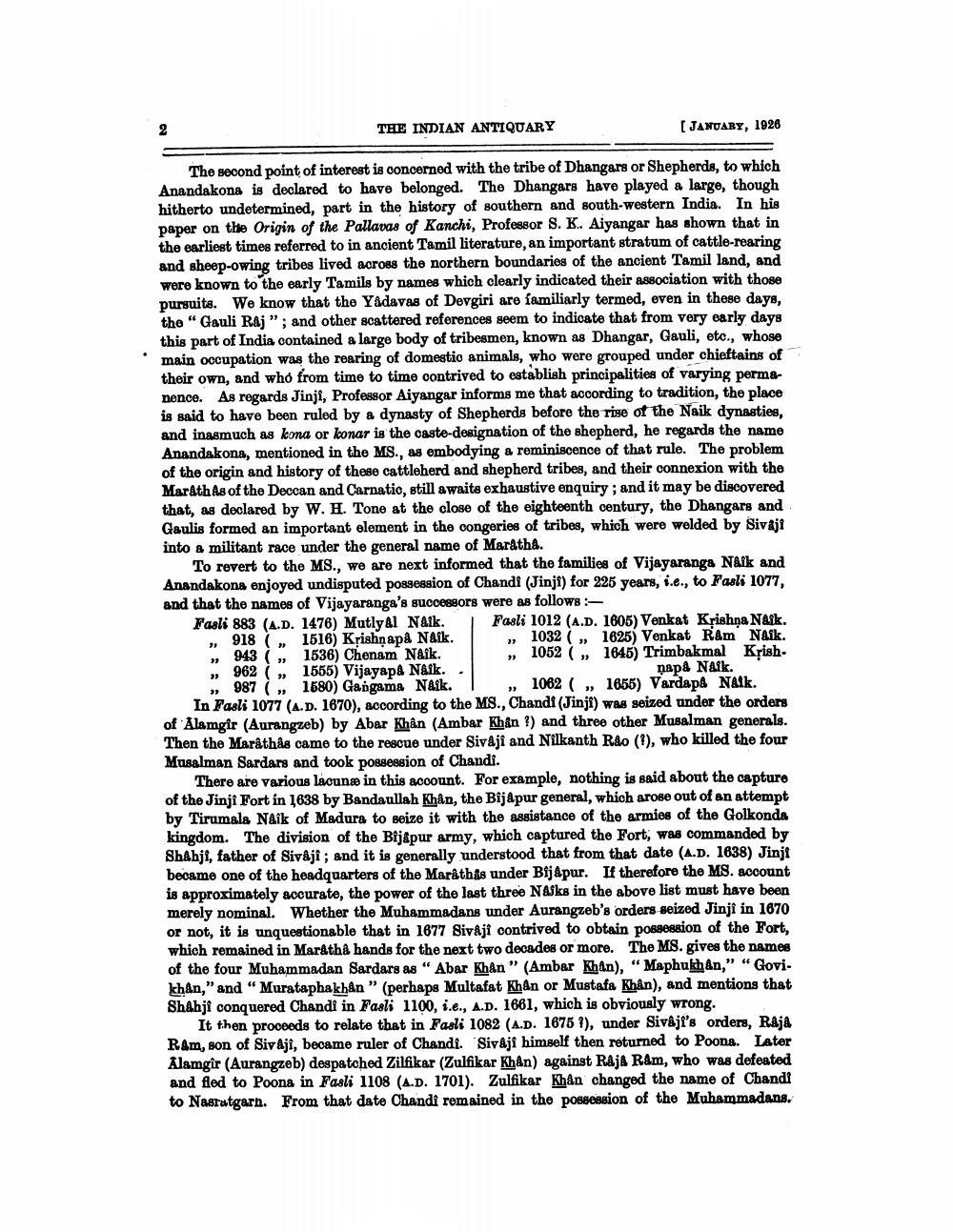Book Title: Indian Antiquary Vol 55 Author(s): Richard Carnac Temple, Stephen Meredyth Edwardes, Krishnaswami Aiyangar Publisher: Swati Publications View full book textPage 8
________________ THE INDIAN ANTIQUARY [ JANUARY, 1928 The second point of interest is concerned with the tribe of Dhangars or Shepherds, to which Anandakona is declared to have belonged. The Dhangars have played a large, though hitherto undetermined, part in the history of southern and south-western India. In his paper on the Origin of the Pallavas of Kanchi, Professor S. K. Aiyangar has shown that in the earliest times referred to in ancient Tamil literature, an important stratum of cattle-rearing and sheep-owing tribos lived across the northern boundaries of the ancient Tamil land, and were known to the early Tamils by names which clearly indicated their association with those pursuits. We know that the Yadavas of Devgiri are familiarly termed, even in these days, the “ Gauli Raj”; and other scattered references seem to indicate that from very early days this part of India oontained a large body of tribesmen, known as Dhangar, Gauli, etc., whose main occupation was the rearing of domestic animals, who were grouped under chieftains of their own, and who from time to time contrived to establish principalities of varying permanence. As regards Jinji, Professor Aiyangar informs me that according to tradition, the place is said to have been ruled by a dynasty of Shepherds before the rise of the Naik dynasties. and inasmuch as kona or konar is the caste-designation of the shepherd, he regards the name Anandakona, mentioned in the MS., as embodying a reminiscence of that rule. The problem of the origin and history of these cattleherd and shepherd tribes, and their connexion with the Marath As of the Deccan and Carnatio, still awaits exhaustive enquiry; and it may be discovered that, as declared by W. H. Tone at the close of the eighteenth century, the Dhangars and Gaulis formed an important element in the congeries of tribes, which were welded by Sivaji into a militant race under the general name of Maratha. To revert to the MS., we are next informed that the families of Vijayaranga Naik and Anandakona enjoyed undisputed possession of Chandi (Jinji) for 225 years, i.e., to Fasli 1077, and that the names of Vijayaranga's successors were as follows: Fasli 883 (A.D. 1476) Mutly Al Naik. Fasli 1012 (A.D. 1805) Venkat Kpishņa Naik. , 918 1516) Krishnapa Naik. 1032 ( 1625) Venkat Ram Naik. , 943 1536) Chenam Naik. ► 1052 (→ 1645) Trimbakmal Krish→ 962 1555) Vijayapa Naik.. napå Naik. » 987 (→ 1580) Gangama Naik. I 1062 (→ 1655) Vardap& Naik. In Fasli 1077 (A.D. 1670), according to the MS., Chandi (Jinji) was seized under the orders of Alamgir (Aurangzeb) by Abar Khân (Ambar Khan ?) and three other Musalman generals. Then the Marathås came to the rescue under Sivaji and Nilkanth Rao (C), who killed the four Musalman Sardars and took possession of Chandi. There are various lacunæ in this account. For example, nothing is said about the capture of the Jinji Fort in 1638 by Bandaullah Khân, the Bijapur general, which arose out of an attempt by Tirumala Naik of Madura to seize it with the assistance of the armies of the Golkonda kingdom. The division of the Bijapur army, which captured the Fort, was commanded by ShAhji, father of Sivaji ; and it is generally understood that from that date (A.D. 1638) Jinjt beoame one of the headquarters of the Marathas under Bijapur. If therefore the MS. account is approximately accurate, the power of the last three Nasks in the above list must have been merely nominal. Whether the Muhammadans under Aurangzeb's orders seized Jinji in 1670 or not, it is unquestionable that in 1677 Sivaji contrived to obtain possession of the Fort. which remained in Marath& hands for the next two decades or more. The MS. gives the names of the four Muhammadan Sardars as "Abar Khân" (Ambar Khin), "Maphukhan," "Govi. khan," and "Murataphakhan " (perhaps Multafat Khan or Mustafa Khan), and mentions that Shahji conquered Chandi in Fasli 1100, i.e., A.D. 1661, which is obviously wrong. It then proceeds to relate that in Fasli 1082 (A.D. 1675 ?), under Sivaji's orders, Raja Ram, son of Sivaji, became ruler of Chandi. Sivaji himself then returned to Poona. Later Alamgir (Aurangzeb) despatched Zilfikar (Zulfikar Khan) against Raja Ram, who was defeated and fled to Poona in Fasli 1108 (A.D. 1701). Zulfikar Khan changed the name of Chandi to Nasratgarh. From that date Chandi remained in the possession of the Muhammadang.Page Navigation
1 ... 6 7 8 9 10 11 12 13 14 15 16 17 18 19 20 21 22 23 24 25 26 27 28 29 30 31 32 33 34 35 36 37 38 39 40 41 42 43 44 45 46 47 48 49 50 51 52 53 54 55 56 57 58 59 60 61 62 63 64 65 66 67 68 69 70 71 72 73 74 75 76 77 78 79 80 81 82 ... 370
